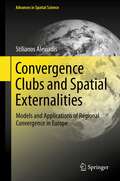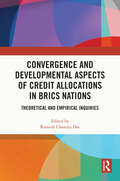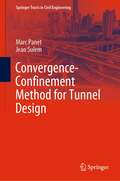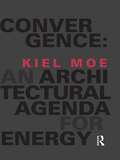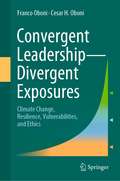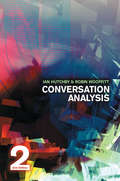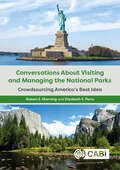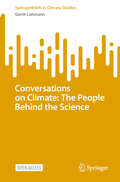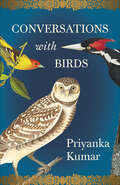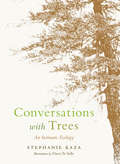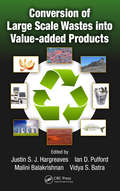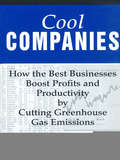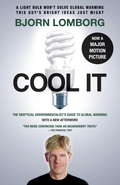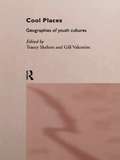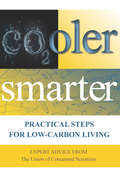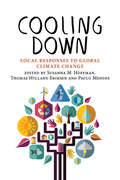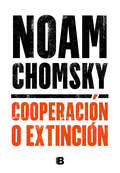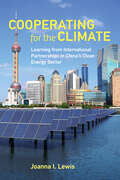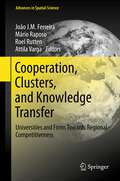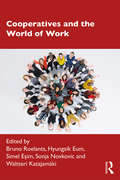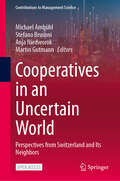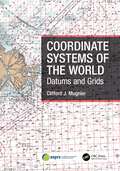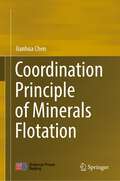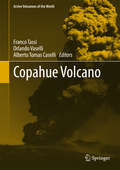- Table View
- List View
Convergence Clubs and Spatial Externalities: Models and Applications of Regional Convergence in Europe (Advances in Spatial Science)
by Stilianos AlexiadisDo dynamic externalities, in the form of technology creation, adoption and spatial agglomeration shape the pattern of regional growth in Europe? This study provides an alternative view on regional convergence. A model is developed which attributes club-convergence to existing differences with respect to the degree of technology adoption. In the first instance, empirical results suggest that the NUTS-2 regions of the EU-27 converge at a very slow rate. Further tests, however, indicate that convergence is restricted to a specific subset of regions. Such conclusions are tested further, using an alternative model of club-convergence, which incorporates the impact of spatial interaction, agglomeration externalities and technology. This shows that the convergence-club in Europe follows a certain geographical pattern and all members share similar characteristics regarding technology creation and adoption, and agglomeration externalities.
Convergence and Developmental Aspects of Credit Allocations in BRICS Nations: Theoretical and Empirical Inquiries
by Ramesh Chandra DasThis book explores the levels of cooperation and the phenomenon of convergence among BRICS nations. It provides an in-depth look into the financial and banking systems among these rapidly developing economies and the steps they have taken to foster development and counter inequalities.Of the many factors in determining the income and wealth of a country as well as a group of countries, commercial bank credit, a well-known financial indicator, has been an important one. This book analyses the governance and structure of the New Development Bank and its effects on group members for peer growth and to defend against any external economic and political shocks. It looks at how much of an influence the commercial bank credit, or simply the credit, has upon the income levels of the BRICS member countries, how equitable they are, whether they are converging in credits and incomes, and other such issues. It also focuses on India’s credit aspects of inclusiveness and convergence.With a strong empirical model estimation, this book will be of interest to students and researchers of economics, finance, management, political studies, international relations, and international trade.
Convergence-Confinement Method for Tunnel Design (Springer Tracts in Civil Engineering)
by Jean Sulem Marc PanetThis book presents the theoretical bases and the application tools for using the 'convergence-confinement' method which is a rational method largely used in design engineering for tunneling. Until recently, the stability conditions of underground works and the choice of support methods were essentially defined on the basis of good practice or empirical methods. The progress made, on one hand on the knowledge of the constitutive laws of soils and rocks and, on the other hand on the numerical modeling of the interaction between the ground and the structures have led to the development of robust design tools for tunnels supports. The convergence-confinement method makes it possible to simulate the excavation of a tunnel and the installation of the support using a simple plane strain model. The book presents the theoretical bases of the method and its most recent developments. Closed-form solutions for stress and displacement fields around tunnels are provided for elastic, viscoelastic and elasto-plastic behavior of the ground. More generally, the principles for applying the method in numerical models are presented.
Convergence: An Architectural Agenda For Energy
by Kiel MoeConvergence is based on the thermodynamic premise that architecture should maximize its ecological and architectural power. No matter how paradoxical it might initially seem, architects should maximize energy intake, maximize energy use, and maximize energy feedback and reinforcement. This presumes that the necessary excess of architecture is in fact an architect’s greatest asset when it comes to an agenda for energy, not a liability. But how do we start to understand the full range of eco-thermodynamic principles which need to be engaged with in order to achieve this? Kiel Moe explicates three factors: materials, energy systems and amortization. When these three factors converge through design, the resulting buildings begin to perform in complex, if not subtle, ways. By drawing on a range of architectural, thermodynamic, and ecological sources as well as illustrated and well-designed case studies, the author shows what architecture stands to gain by simultaneously maximizing the architectural and ecological power of buildings. .
Convergent Leadership-Divergent Exposures: Climate Change, Resilience, Vulnerabilities, and Ethics
by Franco Oboni Cesar H. OboniThis book aims, through its chapters, at providing the knowledge to make competent decisions, convince peers or top management to take appropriate action, or beat out the competition for climate adaptation measures including adjustments for design and operations. Topics discussed include business-as-usual vs. divergence; the effects of public pressure on corporate, industrial and government decision making; techniques for gathering the proper information to assess risks and hazards; the importance determining risk tolerance thresholds; the difference between tolerable risks, intolerable ones that benefit from mitigation and those that require strategic shifts; why common practice approaches such as FMEA, and risk matrices are inadequate in today’s world and do not help ensure infrastructural and systemic resilience and sustainability.Case histories and three complete case studies that can be adapted to any industry or project walk the reader step by step from client request to recommendations and conditions of validity. The ultimate aim is to understand how to reduce risks to tolerable and societally acceptable levels while simultaneously creating sustainable and ethical systems.
Conversation Analysis
by Ian Hutchby Robin WooffittTalk is a central activity in social life. But how is ordinary talk organized? How do people coordinate their talk in interaction? And what is the role of talk in wider social processes? Conversation Analysis has developed over the past forty years as a key method for studying social interaction and language use. Its unique perspective and systematic methods make it attractive to an interdisciplinary audience. In this second edition of their highly acclaimed introduction, Ian Hutchby and Robin Wooffitt offer a wide-ranging and accessible overview of key issues in the field. The second edition has been substantially revised to incorporate recent developments, including an entirely new final chapter exploring the contribution of Conversation Analysis to key issues in social science. The book provides a grounding in the theory and methods of Conversation Analysis, and demonstrates its procedures by analyzing a variety of concrete examples. Written in a lively and engaging style, Conversation Analysis has become indispensable reading for students and researchers in sociology, sociolinguistics, applied linguistics, social psychology, communication studies and anthropology.
Conversations About Visiting and Managing the National Parks: Crowdsourcing America’s Best Idea
by Robert Manning Dr Elizabeth E. PerryAs the popularity of the national parks grows, so do the challenges of visiting and managing them. This innovative book uses crowdsourcing - postings by park visitors on a range of social media sites - to start 100 conversations on issues associated with visiting and managing the national parks. The authors then use their experience and expertise to prepare short, plainspoken, and engaging essays that respond to the postings and complete the conversations. The book is written for park visitors, managers, and students. The authors are university professors who teach the history, philosophy, and management of national parks, conduct long-term programs of research for the National Park Service, and have spent years working and living in the national parks. This inventive, thoughtful, and inviting book addresses a wide range of national park-related issues, guides readers on how to more effectively plan and conduct their national park visits, informs park planners and managers about what visitors think about the parks, introduces the latest scientific and professional information on park management, helps prepare students for careers in park management, and enhances public appreciation and protection of the national parks. Preservation of our national parks has always required an active engagement with the public. The authors take this to a new level by responding directly to the many questions and comments posed by visitors on social media with thoughtful and informative responses. Jonathan B. Jarvis, eighteenth Director of the National Park Service
Conversations on Climate: The People Behind the Science (SpringerBriefs in Climate Studies)
by Gerrit LohmannThis open access book presents interviews with high-profile climate scientists about state-of-the-art research questions. Consequences of climate change have become more and more visible and are now regularly discussed in political and societal debates. While climate scientists have been warning about potential consequences of anthropogenic greenhouse gas emissions for decades, their call for action has not sufficiently been heard for long. Meanwhile, the field of climate science has grown significantly and become more interdisciplinary. As a result, more sophisticated technologies, higher data availability as well as more advanced climate models have made the fundamental message stronger than ever: The impact of human activity on the Earth’s climate is clear and severe and irreversible consequences already occur all over the world. The authors were given the opportunity to talk to leading climate scientists from different disciplines. These do not only include theoretical physics, paleo-research, and climate modelling, but also cover the role of the biosphere, extreme weather events, and attribution science. Additionally, the interviews also address the political dimension of climate science.
Conversations with Birds
by Priyanka Kumar“An eloquent depiction of how birding engenders a deep love of our ecosystems and a more profound understanding of ourselves.” —Kirkus Reviews (starred review)Growing up at the feet of the Himalayas in northern India, acclaimed filmmaker and novelist Priyanka Kumar took for granted her immersion in a lush natural world. After moving to North America as a teenager, she found herself increasingly distanced from nature and discouraged by the civilization she saw contributing to its destruction. It was only in her twenties, living in Los Angeles and working on films, that she began to rediscover her place in the landscape—and in the cosmos—by way of watching birds.Tracing her movements across the American West, this stirring collection of essays brings the avian world richly to life. Kumar’s perspective is not that of a list keeper, counting and cataloguing species. Rather, from the mango-colored western tanager that rescues her from a bout of altitude sickness in Sequoia National Park to ancient sandhill cranes in the Bosque del Apache National Wildlife Refuge, and from the snowy plovers building shallow nests with bits of shell and grass to the white-breasted nuthatch that regularly visits the apricot tree behind her family’s casita in Santa Fe, for Kumar, birds “become a portal to a more vivid, enchanted world.”Kumar’s reflections on these messengers from our distant past and harbingers of our future offer luminous evidence of her suggestion that “seeds of transformation lie dormant in all of our hearts. Sometimes it just takes the right bird to awaken us.”
Conversations with Trees: An Intimate Ecology
by Stephanie KazaFrom a pioneering thinker in the field of religion and ecology, a collection of evocative meditations on the beauty, fragility, and resilience of trees. Included are twenty-seven original lithographs of the trees profiled in each chapter.First published in 1993, Stephanie Kaza's heartfelt book helped thousands of readers kindle a sense of spiritual connection through communing with our ancient relatives - trees. Shambhala Publications is proud to reissue this book, with a beautiful new cover and a new Introduction by the author. More pertinent now than ever, Kaza's intimate exploration of the lives and relationships of individual trees exemplifies the conjunction of inquiry and emotion, of science and spirituality. In an era of species extinction and worsening climate change, this book is a warm and earnest invitation to personal and ecological sanity.
Conversion of Large Scale Wastes into Value-added Products
by Malini Balakrishnan Justin S. J. Hargreaves Vidya S. Batra Ian D. PulfordThis book describes how large-scale wastes can be used as a resource for making other materials. It covers metal processing wastes (slag, red mud), fly ash from coal combustion, electronic waste, and food waste. These wastes have potential to be used in bulk (e.g., for construction applications) as well as for niche applications (e.g., in the areas of catalysis). This book reviews literature from around the world on how large-scale wastes are in use by industry as well as research on the potential applications of wastes.
Cool Cities: Urban Sovereignty and the Fix for Global Warming
by Benjamin R. BarberA pointed argument that cities—not nation-states—can and must take the lead in fighting climate change Climate change is the most urgent challenge we face in an interdependent world where independent nations have grown increasingly unable to cooperate effectively on sustainability. In this book, renowned political theorist Benjamin R. Barber describes how cities, by assuming important aspects of sovereignty, can take the lead from faltering nation states in fighting climate change. Barber argues that with more than half the world's population now in urban areas, where 80 percent of both GDP and greenhouse gas emissions are generated, cities are the key to the future of democracy and sustainability. In this compelling sequel to If Mayors Ruled the World, Barber assesses both broad principles of urban rights and specific strategies of sustainability such as fracking bans, walkable cities, above-ground mining of precious resources, energy and heating drawn from garbage incineration, downtown wind turbines, and skyscrapers built from wood. He shows how cities working together on climate change, despite their differences in wealth, development, and culture, can find common measures by which to evaluate the radically different policies they pursue. This is a book for a world in which bold cities are collaborating to combat climate change and inspire hope for democracy even as reactionary populists take over national governments in the United States and Europe. It calls for a new social contract among citizens and municipalities to secure not only their sustainability but their survival.
Cool Companies: How The Best Businesses Boost Profits And Productivity By Cutting Greenhouse-Gas Emissions
by Joseph J. RommDespite ongoing negotiations, consensus has not yet been reached on what action will be taken to combat global warming. A number of companies have looked beyond the current stalemate to see the prospect of reducing greenhouse-gas emissions not as a roadblock to growth and innovation but as a unique opportunity to increase profits and productivity. These "cool" companies understand the strategic importance of reducing heat-trapping emissions and have worked to cut their emissions by fifty percent or more. In the process, they have not only reduced their energy bill, but have increased their productivity, sometimes dramatically.In Cool Companies, energy expert Joseph Romm describes the experiences of these remarkable firms, as he presents more than fifty case studies in which bottom line improvements have been achieved by improving processes, increasing energy efficiency, and adopting new technologies. Romm places efforts to reduce emissions in the context of proven corporate strategies, showing managers how they can build or retrofit their operations with the latest technologies to reduce emissions and achieve quick returns on the investment. Case studies illustrate the concept of "lean production" and why systematic efforts to reduce emissions so often lead to productivity gains; explain how changes in office and building design can significantly increase productivity; present options for "cool" power -- from cogeneration to solar, wind, and geothermal energy; and explain energy efficiency in manufacturing.In profiling successful companies such as DuPont, 3M, Compaq, Xerox, Toyota, Verifone, Perkin-Elmer, and Centerplex, among many others, Cool Companies turns on its head the notion that the effort to combat global warming will come with massive costs to the industrial sector. It is a unique and essential business book for anyone concerned with increasing profits and productivity while reducing greenhouse gas emissions.
Cool It: The Skeptical Environmentalist's Guide to Global Warming
by Bjørn LomborgGlobal warming has become one of the permanent concerns of our time, with ever stronger calls to combat it via drastic programs, like the Kyoto Protocol. In this highly controversial book, Bjorn Lomborg (author of the bestselling The Skeptical Environmentalist) claims that the arguments for such action are little more than scare mongering and exposes this wide range of disinformation. Global warming is happening. It's a serious and important problem and we need to deal with it in a responsible way. B...
Cool Places: Geographies of Youth Cultures
by Gill Valentine Tracey SkeltonCool Places explores the contrasting experiences of contemporary youth. The chapters draw on techno music and ecstasy in Germany, clubbing in London, global backpacking and gangs in Santa Cruz as well as expereinces at home, on the streets and seeking employment. The contributors use these examples to explore representation and resistance and geographical concepts of scale and place in young people's lives within social, cultural and feminist studies to focus upon the complexities of youth cultures and their spatial representations and interactions. Contributors: Shane Blackman, Sophie Bowlby, Myrna Margulies Breitbart, Deborah Chambers, Luke Deforges, Claire Dwyer, Keith Hetherington, Cindi Katz, Heinz-Herman Kruger, Marion Leonard, Sally Lloyd Evans, Tim Lucas, Sara McNamee,Ben Malbon, Doreen Massey, Robina Mohammad, David Oswell, David Parker, Birgit Richard, Susan Ruddick, Tracey Skelton, Fiona Smith, Kevin Stevenson, Gill Valentine and Paul Watt
Cooler Smarter: Practical Steps for Low-Carbon Living
by David Friedman Seth Shulman The Union of Concerned Scientists Margaret Mellon Jeff Deyette Brenda EkwurzelHow can each of us live Cooler Smarter? While the routine decisions that shape our days--what to have for dinner, where to shop, how to get to work--may seem small, collectively they have a big effect on global warming. But which changes in our lifestyles might make the biggest difference to the climate? This science-based guide shows you the most effective ways to cut your own global warming emissions by twenty percent or more, and explains why your individual contribution is so vital to addressing this global problem. Cooler Smarter is based on an in-depth, two-year study by the experts at The Union of Concerned Scientists. While other green guides suggest an array of tips, Cooler Smarter offers proven strategies to cut carbon, with chapters on transportation, home energy use, diet, personal consumption, as well as how best to influence your workplace, your community, and elected officials. The book explains how to make the biggest impact and when not to sweat the small stuff. It also turns many eco-myths on their head, like the importance of locally produced food or the superiority of all hybrid cars. The advice in Cooler Smarter can help save you money and live healthier. But its central purpose is to empower you, through low carbon-living, to confront one of society's greatest threats.
Cooling Down: Local Responses to Global Climate Change
by Paulo Mendes Susanna M. Hoff man, Thomas Hylland EriksenClimate change is a slowly advancing crisis sweeping over the planet and affecting different habitats in strikingly diverse ways. While nations have signed treaties and implemented policies, most actual climate change assessments, adaptations, and countermeasures take place at the local level. People are responding by adjusting their practices, livelihoods, and cultures, protesting and migrating. This book portrays the diversity of explanations and remedies as expressed at the community level and its emphasis on the crucial importance of ethnographic detail in demonstrating how people in different parts of the world are scaling down the phenomenon of global warming.
Cooperación o extinción
by Noam ChomskyUn texto imprescindible para tomar conciencia y pasar a la acción. Cooperación o extinción es la última novedad del lingüista, filósofo, politólogo Noam Chomsky, también uno de los activistas más influyentes del mundo. En esta ocasión, se trata de una recopilación de textos que nace de un llamado «Encuentro Chomsky» celebrado en Boston y dedicado a las amenazas a la supervivencia planetaria, cuyos tres temas fundamentales son la emergencia climática, la amenaza nuclear y el peligro que entraña el debilitamiento del sistema democrático en todo el mundo. La solución pasa, según indica Chomsky en estas páginas reveladoras, por el activismo social e internacional: una serie de movimientos populares que ya se están organizando por todo el globo para forzar acuerdos inte rnacionales y afrontar este reto sin precedentes por la supervivencia de la civilización. «No se puede pasar por alto la alarma de una «extinción inminente». Debería constituir un eje central firme de todo programa de concienciación, organización y activismo; figurar como trasfondo de cualquier forma de participación en todas las demás luchas. Y algo así presupone una sensibilidad más amplia hacia los problemas e injusticias que hostigan al mundo, una toma de conciencia más profunda, que sirva para inspirar un activismo comprometido, con un enfoque más penetrante sobre las raíces de tales asuntos y las interrelaciones que entre ellos se dan.» La crítica ha dicho:«Para cualquiera que quiera descubrir más sobre el mundo en que vivimos [...] hay una respuesta simple: lee a Noam Chomsky.»New Statesman
Cooperating for the Climate: Learning from International Partnerships in China's Clean Energy Sector
by Joanna I. LewisThe intricacies, politics, and prospects of international cooperation, particularly with China, to address climate change.No country in the world releases more greenhouse gases than China. And no country has a greater capacity—and ambition—to mitigate climate change. This deeply informed, urgently needed book examines the global cooperation such a monumental effort demands and inspires, necessarily focusing on China&’s outsize role in the development and dissemination of clean energy technologies. Drawing on decades of work in clean energy and climate technology and policy, Joanna Lewis provides a clear and thorough account of the motivations, science, and politics behind international clean energy technology collaboration—and an in-depth look at why different clean energy partnerships result in different political and technological outcomes. The first comprehensive analysis of international clean energy partnerships with China, Cooperating for the Climate is based on hundreds of interviews with government officials, researchers, and private companies involved in these collaborative initiatives around the world. Its insights into energy innovation and international relations, as well as global environmental politics, will help international stakeholders navigate the complex political bureaucracy governing clean energy development in China and perhaps chart a productive pathway for moving the world toward a low-carbon future.
Cooperation, Clusters, and Knowledge Transfer: Universities and Firms Towards Regional Competitiveness (Advances in Spatial Science #77)
by Attila Varga Roel Rutten Joao J Ferreira Mário RaposoCooperation and clusters have become the guiding paradigms for explaining and promoting regional competitiveness, but the cooperation process between firms and universities and the transfer of knowledge in guiding and nurturing regional competitiveness has received relatively little attention. This book strives to fill this gap in highlighting the connection between inter-firm cooperation in regional clusters, innovation and regional networks, and the role of universities in them . It goes beyond the traditional economic approach of clusters and includes 'soft factors' in the explanation of regional competitiveness, and connects the literature on clusters to the literature of learning and knowledge creation as sources of regional competitiveness. It aims to foster an international and interdisciplinary exchange of perspectives by presenting current developments, case studies, best practices as well as new integrated theoretical approaches and applications.
Cooperatives and the World of Work
by Sonja Novkovic Bruno Roelants Hyungsik Eum Simel Esim Waltteri KatajamäkiAs the world of work and jobs is more uncertain than ever because of various trends impacting it, including the rise of robotics and the gig economy, Cooperatives and the World of Work furthers the debate on the future of work, sustainable development, and the social and solidarity economy of which cooperatives are a fundamental component. Throughout the book, the authors, who are experts in their respective fields, do not limit themselves to praising the advantages of the cooperative model. Rather, they challenge the narrow understanding of cooperatives as a mere business model and raise debate on the more fundamental role that cooperatives play in responding to social changes and in changing society itself. The book is unique in tracing the historical connection between cooperatives and the world of work since the end of the First World War and the recent shifts and restructuring in enterprise and the workplace. It presents a redefinition of the very concept of work, focusing on organizational innovation. This book is published in recognition of 100 years of the International Labour Organization, and gathers together research from leading experts who were brought together at an event co-hosted by the International Co-operative Alliance (ICA) and the International Labour Organization (ILO).
Cooperatives in an Uncertain World: Perspectives from Switzerland and Its Neighbors (Contributions to Management Science)
by Stefano Brusoni Martin Gutmann Michael Ambühl Anja NiedworokThis book focuses on different aspects of cooperatives in Switzerland and its neighboring countries, and their contribution to meeting overarching societal challenges. It seeks to identify how cooperatives can tackle grand societal challenges and extends the body of research on cooperatives. The discussions are highlighted in the context of the UN’s Sustainable Development Goals. The respective chapters cover topics such as cooperatives in Switzerland (historical roots, current landscape, embeddedness in profit/nonprofit organizations, participatory governance and legal aspects), grand societal challenges and cooperatives, and the future with and of cooperatives. This is an open access book.
Coordinate Systems of the World: Datums and Grids
by Clifford J. MugnierA comprehensive consolidation of data for the world, this book gives a short precis of each nation, each nation’s history, its topography and a chronology of the development of geodetic surveying and coordinate systems for that specific nation. This book is a starting point of information for understanding the world’s datums and grids. Based on the details available for each nation, the reader is given an overall view that can answer questions regarding the sources of spatial information available, their limitations, and the critical things to be aware. The topographic maps compiled over the centuries represent the mixes of technology specifically to that nation. The book provides information and clues regarding existing maps and how those maps and coordinate systems were created.
Coordination Principle of Minerals Flotation
by Jianhua ChenThe advent of flotation, with selective interaction of reagents with minerals at its core, has greatly advanced the development of modern mining. Ever since, there has been continuous researched into the mechanism of mineral-reagent interactions, in an effort to design and develop more effective reagents. A unique perspective from coordination is presented to illustrate the principles of reagent molecules interacting with metal ions on mineral surface. For the first time, the influence is unveiled of mineral crystal structures and surrounding atoms on metal ion properties and further on mineral-reagent interactions. The introduction of classical theories for modern chemistry, including orbital structure, electron spin and orbital symmetry matching, into flotation is realized. Researchers, engineers and graduate students among others in the field of mineral processing may gain new insight into flotation and the development of novel reagents.
Copahue Volcano (Active Volcanoes of the World)
by Franco Tassi Orlando Vaselli Alberto Tomas CaselliThis book provides a comprehensive description of the volcanological, petrological and geochemical features of the Copahue volcano, located at the border between Argentina and Chile. Scientific studies are limited for this volcanic system, due to its remote location and difficult access in winter. However, Copahue is one of the most active volcanic systems in the southern Andes. Monitoring the volcano's activity is of utter importance, as it provides means of existence for the nearby village of the same name, hosting the world's highest-located hot-springs resort. This book's aim is to present the current monitoring activities, and to describe future research programs that are planned in order to mitigate volcanic hazards. Special attention is therefore devoted to the social and industrial activities close to the volcano, such as health therapies and geothermal energy exploitation. In a special section, the Copahue volcano is presented as a terrestrial modern analog for early-Earth and Mars environments.
